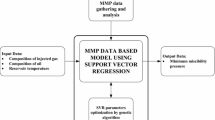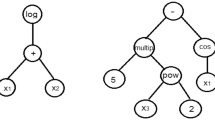Abstract
Gas injection is a proven economical process that significantly increases oil and condensate recovery from hydrocarbon reservoirs. Relative permeability is an important parameter in modeling, simulation, and evaluation of gas injection. In this study, new empirical-mathematical models are developed to predict the relative permeability of gas-oil systems in different rock and fluid systems. The Multi-Gene Genetic Programming (MGGP) technique is employed to develop relative permeability equations. The smart correlations presented in this work require capillary number, interfacial tension, API, gas molecular weight, and viscosity ratio as extra input variables to improve its precision and accuracy. The significance of each parameter is evaluated by statistical approach and Taguchi experimental design. The new models are evaluated by experimental data extracted from literature and validated by extensive error analysis. Additionally, laboratory tests were performed for determining gas-oil relative permeability which were used to check the accuracy of new developed correlations. In relative permeability curves for different gas flow rates, the coupling effect becomes strong and, in competition with the inertia effect, causes changes in the relative permeability with flow rate. The comparison of the experimental results of this study with the new proposed correlation resulted in a root-mean-square error (RMSE) of 0.0796 for gas relative permeability and 0.0564 for oil relative permeability. The results strongly admit the MGGP approach and high accuracy of developed mathematical correlations.
Similar content being viewed by others
Abbreviations
- K abs :
-
absolute permeability
- \(S_{\mathrm {g},\max }\) :
-
maximum gas saturation
- API:
-
American Petroleum Institute gravity
- MWg :
-
gas molecular weight
- IFT:
-
interfacial tension
- μ g/μ o :
-
ratio of gas viscosity to oil viscosity
- N ca :
-
capillary number
- k ro :
-
oil relative permeability
- S o :
-
oil saturation
- S g :
-
gas saturation
- \(S_{\mathrm {o},\max }\) :
-
maximum oil saturation
- S wc :
-
connate water saturation
- S or :
-
residual oil saturation
- S gc :
-
critical gas saturation
- \(K_{\text {ro},\max }\) :
-
critical gas saturation
- \(K_{\text {ro},\max }\) :
-
maximum oil relative permeability
- \(K_{\text {rg},\max }\) :
-
maximum gas relative permeability
- k rg :
-
gas relative permeability
References
Shaidi, S.MA.: Modelling of gas-condensate flow in reservoir at near wellbore conditions Heriot-Watt University (1997)
Kundu, P., Kumar, V., Mishra, I.M.: Experimental and numerical investigation of fluid flow hydrodynamics in porous media: characterization of pre-Darcy, Darcy and non-Darcy flow regimes. Powder Technol. 303, 278–291 (2016)
Ostos, A., Maini, B.: Capillary number in heavy oil solution gas drive and its relationship with gas-oil relative permeability curves. In: SPE/DOE Symposium on Improved Oil Recovery (2004)
Honarpour, M., Mahmood, S.: Relative-permeability measurements: an overview. J. Pet. Technol. 40, 963–966 (1988)
Blom, S., Hagoort, J.: How to include the capillary number in gas condensate relative permeability functions?. In: SPE Annual Technical Conference and Exhibition (1998)
Ali, J., Butler, S., Allen, L., Wardle, P.: The influence of interfacial tension on liquid mobility in gas condensate systems. In: Offshore Europe (1993)
Asar, H., Handy, L.L.: Influence of interfacial tension on gas/oil relative permeability in a gas-condensate system. SPE Reserv. Eng. 3, 257–264 (1988)
Haniff, M., Ali, J.: Relative permeability and low tension fluid flow in gas condensate systems. In: European Petroleum Conference (1990)
Longeron, D.: Influence of very low interfacial tensions on relative permeability. Soc. Pet. Eng. J. 20, 391–401 (1980)
Corey, A.T.: The interrelation between gas and oil relative permeabilities. Producers Monthly 19, 38–41 (1954)
Honarpour, M., Koederitz, L., Harvey, A.H.: Empirical equations for estimating two-phase relative permeability in consolidated rock. J. Pet. Technol. 34, 2,905–2,908 (1982)
Lomeland, F., Ebeltoft, E., Thomas, W.H.: A new versatile relative permeability correlation. In: International Symposium of the Society of Core Analysts. Toronto, Canada (2005)
Chierici, G.L.: Novel relations for drainage and imbibition relative permeabilities. Soc. Pet. Eng. J. 24, 275–276 (1984)
Ibrahim, M., Koederitz, L.: Two-phase relative permeability prediction using a linear regression model. In: SPE Eastern Regional Meeting (2000)
Kam, S., Rossen, W.: A model for foam generation in homogeneous media. SPE J. 8, 417–425 (2003)
Coats, K.H.: An equation of state compositional model. Soc. Pet. Eng. J. 20, 363–376 (1980)
Amaefule, J.O., Handy, L.L.: The effect of interfacial tensions on relative oil/water permeabilities of consolidated porous media. Soc. Pet. Eng. J. 22, 371–381 (1982)
Fulcher, R.A. Jr, Ertekin, T., Stahl, C.: Effect of capillary number and its constituents on two-phase relative permeability curves. J. Pet. Technol. 37, 249–260 (1985)
Betté, S., Hartman, K., Heinemann, R.: Compositional modeling of interfacial tension effects in miscible displacement processes. J. Pet. Sci. Eng. 6, 1–14 (1991)
Whitson, C.H, Fevang, Ø: Generalized pseudopressure well treatment in reservoir simulation. In: Proc. IBC Conference on Optimisation of Gas Condensate Fields (1997)
Nghiem, L.X., Fong, D., Aziz, K.: Compositional modeling with an equation of state (includes associated papers 10894 and 10903). Soc. Pet. Eng. J. 21, 687–698 (1981)
Wang, P., Stenby, E.H., Pope, G.A., Sepehrnoori, K.: Simulation of flow behavior of gas condensate at low interfacial tension. In Situ 20, 199–219 (1996)
Coats, K.H.: An equation of state compositional model. Soc. Pet. Eng. J. 20, 363–376 (1980)
Mohamadi-Baghmolaei, M., Azin, R., Sakhaei, Z., Mohamadi-Baghmolaei, R., Osfouri, S.: Novel method for estimation of gas/oil relative permeabilities. J. Mol. Liq. 223, 1185–1191 (2016)
Mohamadi-Baghmolaei, M., Azin, R., Zarei, Z., Osfouri, S.: Presenting decision tree for best mixing rules and Z-factor correlations and introducing novel correlation for binary mixtures. Petroleum 2, 289–295 (2016)
MohamadiBaghmolaei, M., Mahmoudy, M., Jafari, D., MohamadiBaghmolaei, R., Tabkhi, F.: Assessing and optimization of pipeline system performance using intelligent systems. J. Nat. Gas Sci. Eng. 18, 64–76 (2014)
Zitzler, E., Thiele, L.: Multiobjective evolutionary algorithms: a comparative case study and the strength Pareto approach. IEEE Trans. Evol. Comput. 3, 257–271 (1999)
Eiben, A.E., Smith, J.E.: Introduction to Evolutionary Computing, vol. 53. Springer, Berlin (2003)
Darwin, C., Bynum, W.F.: The origin of species by means of natural selection: or the preservation of favored races in the struggle for life: AL Burt (2009)
Banzhaf, W., Nordin, P., Keller, R.E., Francone, F.D.: Genetic Programming: an Introduction vol 1: Morgan Kaufmann San Francisco (1998)
Koza, J., Bennett, F., Stiffelman, O.: Genetic programming as a Darwinian invention machine. Genet. Program. 651–651 (1999)
Garg, A., Garg, A., Tai, K.: A multi-gene genetic programming model for estimating stress-dependent soil water retention curves. Comput. Geosci. 18, 45 (2014)
Vijayaraghavan, V., Garg, A., Wong, C., Tai, K.: Estimation of mechanical properties of nanomaterials using artificial intelligence methods. Appl. Phys. A 116, 1099–1107 (2014)
Roy, R.K.: Design of Experiments Using the Taguchi Approach, vol. 16. Wiley, New York (2001)
Al-Abri, A., Sidiq, H., Amin, R.: Mobility ratio, relative permeability and sweep efficiency of supercritical CO 2 and methane injection to enhance natural gas and condensate recovery: coreflooding experimentation. J. Nat. Gas Sci. Eng. 9, 166–171 (2012)
Badrul, M.J., Ucok, W.S., Robert, L.L.: Effect of permeability distribution and interfacial tension on gas condensate relative permeability: an experimental study. In: SPE Asia Pacific Oil and Gas Conference and Exhibition (2003)
Henderson, G., Danesh, A., Tehrani, D., Al-Kharusi, B.: The relative significance of positive coupling and inertial effects on gas condensate relative permeabilities at high velocity. In: SPE Annual Technical Conference and Exhibition (2000)
Henderson, G., Danesh, A., Tehrani, D., Peden, J.: The effect of velocity and interfacial tension on relative permeability of gas condensate fluids in the wellbore region. J. Petroleum Sci. Eng. 17, 265–273 (1997)
Kalla, S., Leonardi, S.A., Berry, D.W., Poore, L.D., Sahoo, H., Kudva, R.A., et al.: Factors that affect gas-condensate relative permeability. In: IPTC 2014: International Petroleum Technology Conference (2014)
Munkerud, P., Torsaeter, O.: The effects of interfacial tension and spreading on relative permeabilityin gas condensate systems. In: IOR 1995-8th European Symposium on Improved Oil Recovery (1995)
Parvazdavani, M., Masihi, M., Ghazanfari, M.: Gas–oil relative permeability at near miscible conditions: an experimental and modeling approach. Sci. Iran. 20, 626–636 (2013)
Shahverdi, H., Sohrabi, M., Fatemi, M., Jamiolahmady, M.: Three-phase relative permeability and hysteresis effect during WAG process in mixed wet and low IFT systems. J. Pet. Sci. Eng. 78, 732–739 (2011)
Fatemi, S.M., Sohrabi, M., Jamiolahmady, M., Ireland, S.: Experimental and theoretical investigation of gas/oil relative permeability hysteresis under low oil/gas interfacial tension and mixed-wet conditions. Energy Fuel 26, 4366–4382 (2012)
Author information
Authors and Affiliations
Corresponding author
Additional information
Publisher’s note
Springer nature remains neutral with regard to jurisdictional claims in published maps and institutional affiliations.
Rights and permissions
About this article
Cite this article
Farmani, Z., Azin, R., Mohamadi-Baghmolaei, M. et al. Experimental and theoretical study of gas/oil relative permeability. Comput Geosci 23, 567–581 (2019). https://doi.org/10.1007/s10596-018-9806-9
Received:
Accepted:
Published:
Issue Date:
DOI: https://doi.org/10.1007/s10596-018-9806-9




